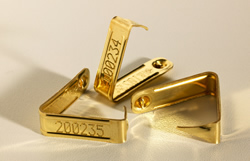
The shortage of angora goat fibre and the increasing world-wide demand is driving mohair values to new levels.
Prices for all types of fibre continues to rise with kid mohair – the most highly sought after – now selling for £6 a kilo compared with £4.50 last year.
The strengthening market is once again focussing attention on the profitability of fibre goat farming which has the potential to generate up to £6000 from a flock of around 80 does, according to the British Angora Goat Society.
Denys Stubbs, who farms in Staffordshire, was one of the first UK breeders to establish a flock of angora goats back in the 1980s.
He's confident about the future of mohair production in the UK and says there has never been a better time to consider setting up a flock.
"World-wide production of angora goat fibre has fallen in recent years and is now less than 25% of its level of 20 years ago. In the UK British Mohair Marketing is producing around nine tonnes a year with individual producers marketing a further five tonnes."
"There's a great opportunity for people to set-up new flocks - either on a small scale or as part of a farm diversification scheme – and move into mohair production," says Mr Stubbs.
But getting into angora goats isn't just for the big-time guys; angora goat breeders are also keen to encourage interest among smallholders who could set up a new flock. Foundation females cost £80-£250 each depending on quality.
Establishing a commercial flock of around 100 females is something the British Angora Goat Society is keen to encourage among farmers looking for a diversification option.
"There are far fewer angora goats than there used to be. In South Africa – which used to produce 60% of the world's mohair – numbers have fallen dramatically and likewise in Texas following the removal of fibre farming subsidies. There's a gap in the market that needs to be filled," says Mr Stubbs.
No reserve stocks of mohair are being held in South Africa, America or Australia so any sudden upswing in demand – prompted by the fashion industry – would send mohair prices rocketing overnight.
Stephen and Jenny Whitley are long-established angora goat breeders who run the Corrymoor flock at Honiton in Devon. The flock was set-up in 1986 with the emphasis on producing fine, kemp-free mohair.
Mohair from the Whitley's angora flock is now used to produce their famous Corrymoor range of socks.
Says Mr Whitley: "Angora goats are shorn twice a year – usually in January and again in mid-summer – with an expected yield of 1.5kg from a six-month-old kid.
"The combined fleece weight from the first year's clip should be at least 3kg giving an earning potential of around £18 at current prices.
The third clip should yield 3-3.5kg and will classify as kid-mohair with the potential to earn another £18. The fourth clip should also yield around 3.5kg although the price, based on quality, will have eased to around £4 a kilo.
"By the end of two years an angora goat could have earned over £40 from fibre sales."
And breeders say there's no problem in selling angora goat fibre. The British Angora Goat Society has set up its own marketing scheme – British Mohair Marketing.
After collection in spring the mohair is sorted, professionally graded and baled and then sold by putting it up for tender to potential purchasers.
"Farming angora goats for mohair is now looking as profitable as it has been for some years. The world-wide shortage of fibre should sustain prices at their current levels and hopefully even lead to a further increase," says Mr Whitley.
